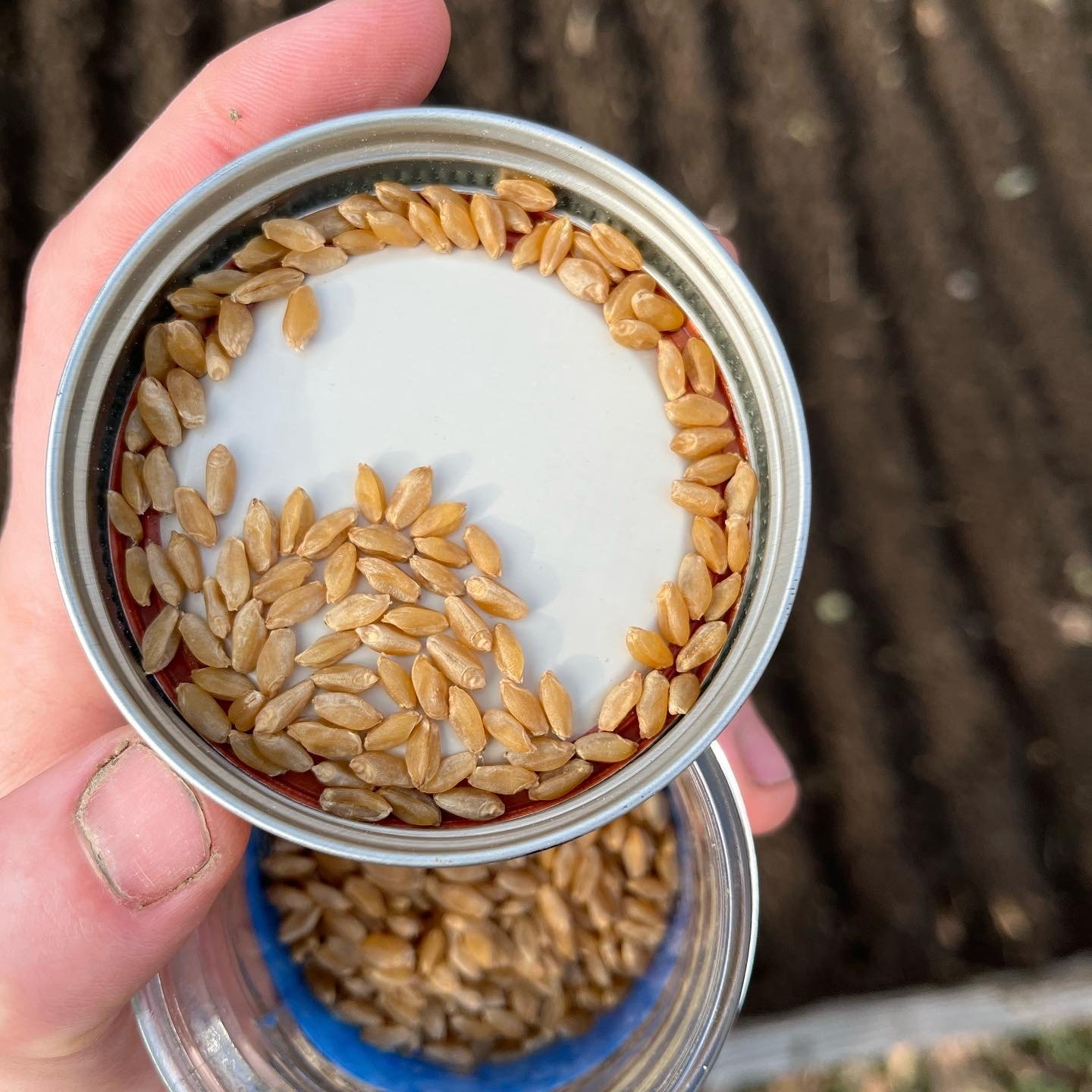Wheat, Hourani
Product Description: (Triticum durum) This ancient durum wheat effortlessly adapts to various applications — from satiny golden pasta dough to airy sourdough boules. In flavor, Hourani has been described as “buttery” with a “nutty, yeasty fragrance”, which we find to be a decidedly faithful characterization.
With deep-rooted origins in the Southern Levant, it’s hard to understate Hourani’s mark on human history. This wheat served as the region’s mainstay grain crop while Christianity was still in its infancy, and almost certainly predates this period by many hundreds (if not thousands) of years.
In 73 CE, an advancing army laid siege on King Herod’s Masada Fortress: the final holdout of Jewish resistance against the Roman occupants of Jerusalem. Within its once-impenetrable walls, 967 men, women, and children took refuge from the attacks for several months — an impressive feat that would have been all but impossible without their extensive caches of sweet-dried dates and Hourani wheat.
While still grown by some inhabitants of the Houran Plateau, Hourani’s population has become severely fragmented since the advent of modern wheat, placing this heritage grain on the edge of extinction. Open-pollinated. Hard white type. Awned. 100 seeds per packet.
Growing Information: Despite early success in our continued efforts to adapt this strain to a cooler climate, Hourani’s lower yield remains its primary pitfall. For the best results, direct seed in full sun as soon as the soil can be worked in the spring. Sow seeds 1 cm (1/2”) deep with 10 cm (4”) spacing in rows 15 cm (6”) apart. When the plants are nearing ankle height, re-sow any patches with thin germination, as this variety performs at its best with neighbors nearby.
Harvest once the stalks have dried down thoroughly and the grains can no longer be dented with your fingernail. If necessary, cut the stalks at the base and tie them into bundles to finish drying indoors. Once ready, separate the grain and stalks with a thresher or by hand, then winnow the isolated grain to remove any remaining chaff. Spring planted. 150 days to maturity.
How To Save Wheat Seeds
Saving wheat seeds is incredibly simple but if you don’t have a mechanized thresher, be sure to wear gloves. Once the seed heads are dry, rub them between your hands to break the seeds loose. Winnow off the chaff, then store the cleaned seeds in a cool, dry location until you are ready to plant again.
Product Description: (Triticum durum) This ancient durum wheat effortlessly adapts to various applications — from satiny golden pasta dough to airy sourdough boules. In flavor, Hourani has been described as “buttery” with a “nutty, yeasty fragrance”, which we find to be a decidedly faithful characterization.
With deep-rooted origins in the Southern Levant, it’s hard to understate Hourani’s mark on human history. This wheat served as the region’s mainstay grain crop while Christianity was still in its infancy, and almost certainly predates this period by many hundreds (if not thousands) of years.
In 73 CE, an advancing army laid siege on King Herod’s Masada Fortress: the final holdout of Jewish resistance against the Roman occupants of Jerusalem. Within its once-impenetrable walls, 967 men, women, and children took refuge from the attacks for several months — an impressive feat that would have been all but impossible without their extensive caches of sweet-dried dates and Hourani wheat.
While still grown by some inhabitants of the Houran Plateau, Hourani’s population has become severely fragmented since the advent of modern wheat, placing this heritage grain on the edge of extinction. Open-pollinated. Hard white type. Awned. 100 seeds per packet.
Growing Information: Despite early success in our continued efforts to adapt this strain to a cooler climate, Hourani’s lower yield remains its primary pitfall. For the best results, direct seed in full sun as soon as the soil can be worked in the spring. Sow seeds 1 cm (1/2”) deep with 10 cm (4”) spacing in rows 15 cm (6”) apart. When the plants are nearing ankle height, re-sow any patches with thin germination, as this variety performs at its best with neighbors nearby.
Harvest once the stalks have dried down thoroughly and the grains can no longer be dented with your fingernail. If necessary, cut the stalks at the base and tie them into bundles to finish drying indoors. Once ready, separate the grain and stalks with a thresher or by hand, then winnow the isolated grain to remove any remaining chaff. Spring planted. 150 days to maturity.
How To Save Wheat Seeds
Saving wheat seeds is incredibly simple but if you don’t have a mechanized thresher, be sure to wear gloves. Once the seed heads are dry, rub them between your hands to break the seeds loose. Winnow off the chaff, then store the cleaned seeds in a cool, dry location until you are ready to plant again.
Product Description: (Triticum durum) This ancient durum wheat effortlessly adapts to various applications — from satiny golden pasta dough to airy sourdough boules. In flavor, Hourani has been described as “buttery” with a “nutty, yeasty fragrance”, which we find to be a decidedly faithful characterization.
With deep-rooted origins in the Southern Levant, it’s hard to understate Hourani’s mark on human history. This wheat served as the region’s mainstay grain crop while Christianity was still in its infancy, and almost certainly predates this period by many hundreds (if not thousands) of years.
In 73 CE, an advancing army laid siege on King Herod’s Masada Fortress: the final holdout of Jewish resistance against the Roman occupants of Jerusalem. Within its once-impenetrable walls, 967 men, women, and children took refuge from the attacks for several months — an impressive feat that would have been all but impossible without their extensive caches of sweet-dried dates and Hourani wheat.
While still grown by some inhabitants of the Houran Plateau, Hourani’s population has become severely fragmented since the advent of modern wheat, placing this heritage grain on the edge of extinction. Open-pollinated. Hard white type. Awned. 100 seeds per packet.
Growing Information: Despite early success in our continued efforts to adapt this strain to a cooler climate, Hourani’s lower yield remains its primary pitfall. For the best results, direct seed in full sun as soon as the soil can be worked in the spring. Sow seeds 1 cm (1/2”) deep with 10 cm (4”) spacing in rows 15 cm (6”) apart. When the plants are nearing ankle height, re-sow any patches with thin germination, as this variety performs at its best with neighbors nearby.
Harvest once the stalks have dried down thoroughly and the grains can no longer be dented with your fingernail. If necessary, cut the stalks at the base and tie them into bundles to finish drying indoors. Once ready, separate the grain and stalks with a thresher or by hand, then winnow the isolated grain to remove any remaining chaff. Spring planted. 150 days to maturity.
How To Save Wheat Seeds
Saving wheat seeds is incredibly simple but if you don’t have a mechanized thresher, be sure to wear gloves. Once the seed heads are dry, rub them between your hands to break the seeds loose. Winnow off the chaff, then store the cleaned seeds in a cool, dry location until you are ready to plant again.






